
Flea, the common name for the order Siphonaptera, includes 2,500 species of small flightless insects that live as external parasites of mammals and birds. Fleas live by ingesting the blood of their hosts. Adult fleas grow to about 3 millimetres long, are usually brown, and have bodies that are "flattened" sideways or narrow, enabling them to move through their hosts' fur or feathers. They lack wings; their hind legs are extremely well adapted for jumping. Their claws keep them from being dislodged, and their mouthparts are adapted for piercing skin and sucking blood. Some species can leap 50 times their body length, a feat second only to jumps made by another group of insects, the superfamily of froghoppers. Flea larvae are worm-like, with no limbs; they have chewing mouthparts and feed on organic debris left on their hosts' skin.

Mecoptera is an order of insects in the superorder Holometabola with about six hundred species in nine families worldwide. Mecopterans are sometimes called scorpionflies after their largest family, Panorpidae, in which the males have enlarged genitals raised over the body that look similar to the stingers of scorpions, and long beaklike rostra. The Bittacidae, or hangingflies, are another prominent family and are known for their elaborate mating rituals, in which females choose mates based on the quality of gift prey offered to them by the males. A smaller group is the snow scorpionflies, family Boreidae, adults of which are sometimes seen walking on snowfields. In contrast, the majority of species in the order inhabit moist environments in tropical locations.
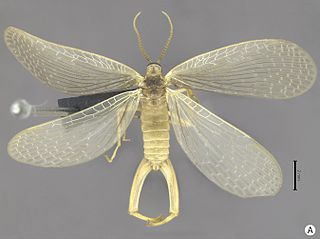
Meropeidae is a family of tiny scorpionflies within the order Mecoptera with only three known living species, commonly referred to as "earwigflies", based on the earwig-like forceps-shaped male genitalia. The living species are the North American Merope tuber, the Western Australian Austromerope poultoni, and the recently discovered South American A. brasiliensis. The biology of these species is essentially unknown, and their larvae have never been seen. The adults have been suggested to probably be saprophagous, though they have never been observed feeding. The fossil record of the group extends back to the Jurassic. The earliest known member is Boreomerope antiqua known from an isolated wing found in the Middle Jurassic Itat Formation of Siberia. Other extinct genera include Burmomerope with three species and Torvimerope with one species are both from the mid Cretaceous (Cenomanian) aged Burmese amber. As such, the extant members of this family can be considered living fossils. These insects are also of interest due to their presumed basal position in the order Mecoptera. Thaumatomerope with four described species all from the Madygen Formation in Kyrgyzstan has historically sometimes been included within the family, it was placed into its own monotypic family, "Thaumatomeropidae." in 2002.
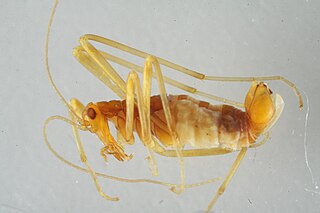
Apteropanorpidae is a family of wingless scorpionflies containing a single genus, Apteropanorpa, with four named species, which are all endemic to the Australian island of Tasmania. Of the four known species, three occupy alpine habitats while A. warra occupies lower elevations.

Nannochoristidae is a family of scorpionflies with many unusual traits. It is a tiny, relict family with a single extant genus, Nannochorista, with eight species occurring in New Zealand, southeastern Australia, Tasmania, Argentina and Chile. Due to the group's distinctiveness from other scorpionflies, it is sometimes placed in its own order, the Nannomecoptera. Some studies have placed them as the closest living relatives of fleas. Most mecopteran larvae are eruciform, or shaped like caterpillars. Nannochoristid larvae, however, are elateriform, and have elongated and slender bodies. The larvae are aquatic, which is unique among mecopterans. The larvae are predatory, hunting on the beds of shallow streams, primarily on the larvae of aquatic Diptera like chironomids. The adults are thought probably to be adapted to liquid feeding, likely on flower nectar and/or the juice of fruits. Adults of Australian and South American species are often found in habitats like the edges of streams, lakes, as well as montane bogs. Australian species have been observed visiting the foliage and flowers of Leptospermum.

Bittacidae is a family of scorpionflies commonly called hangingflies or hanging scorpionflies.

Boreidae, commonly called snow scorpionflies, or in the British Isles, snow fleas are a very small family of scorpionflies, containing only around 30 species, all of which are boreal or high-altitude species in the Northern Hemisphere.

The Panorpidae are a family of scorpionflies containing more than 480 species. The family is the largest family in Mecoptera, covering approximately 70% species of the order. Species range between 9–25 mm long.

Eomeropidae is a family of aberrant, flattened scorpionflies represented today by only a single living species, Notiothauma reedi, known from the Nothofagus forests in southern Chile, while all other recognized genera in the family are known only as fossils, with the earliest definitive fossil known from Liassic-aged strata, and the youngest from Paleogene-aged strata.

Notiothauma is the sole living genus in the scorpionfly family Eomeropidae. The genus is monotypic with a lone species Notiothauma reedi which is native to the Valdivian temperate rain forests of central Chile, especially the forests with Nothofagus stands. N. reedi is flattened with a notedly cockroach-like appearance. They are nocturnal and inhabit the forest floor where the adults feed on plants and decaying animals. The larvae are still unknown. Because this is the last extant species of Eomeropidae, N. reedi can be characterized as a living fossil taxon.

Dryinidae is a cosmopolitan family of solitary wasps. Its name comes from the Greek drys for oak: Latreille named the type genus Dryinus because the first species was collected on an oak tree in Spain. The larvae are parasitoids of the nymphs and adults of Auchenorrhyncha. Dryinidae comprises over 1900 described species, distributed in 11 extant subfamilies and 57 genera.
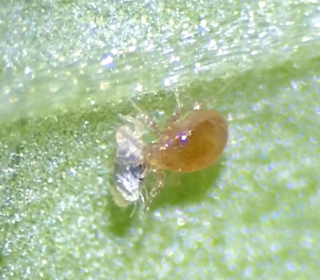
The Phytoseiidae are a family of mites which feed on thrips and other mite species. They are often used as a biological control agent for managing mite pests. Because of their usefulness as biological control agents, interest in Phytoseiidae has steadily increased over the past century. Public awareness of the biological control potential of invertebrates has been growing, though mainly in the US and Europe. In 1950, there were 34 known species. Today, there are 2,731 documented species organized in 90 genera and three subfamilies.

Panorpa communis, the common scorpionfly, is a species of scorpionfly.

Toxomerus is a very large genus of hoverflies. They are found in many parts of North and South America. Most larvae are predators on soft bodied insects, though a few species have been shown to feed on pollen. Adults feed on the pollen of a wide range of flowers.
Ascidae is a family of mites in the order Mesostigmata.
Sinopanorpa is a genus of scorpionflies.

Harpobittacus is a genus of hangingfly of the family Bittacidae found in Australia.
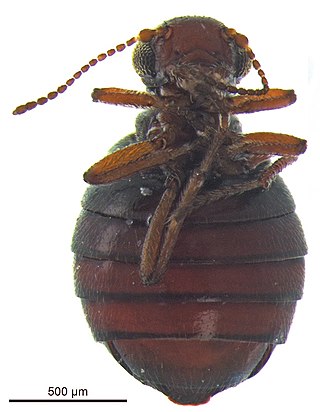
Caurinus is a genus of snow scorpionflies in the family Boreidae. There are at least two described species in Caurinus.
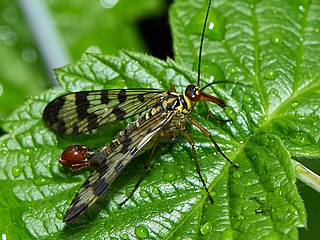
Panorpa vulgaris, also known by its common name meadow scorpionfly is a species from the genus Panorpa. The species was first described in 1845.
Agrotis kuamauna is a species of owlet moth endemic to the alpine high elevations of Mauna Kea on the big island of Hawai'i.
















